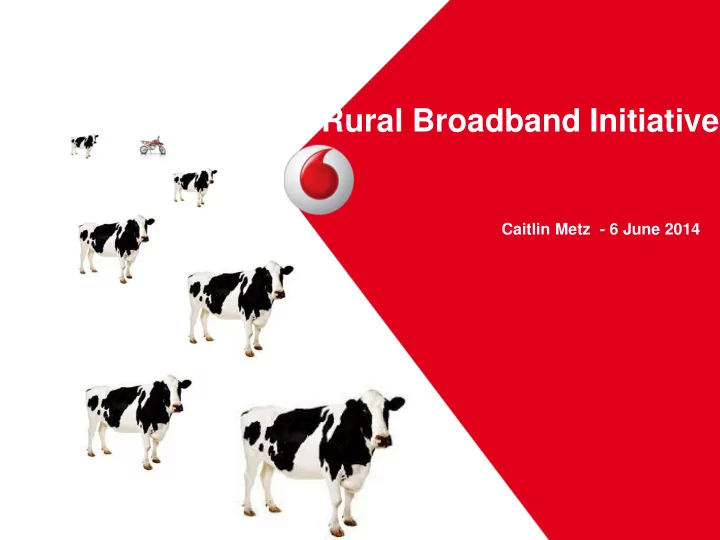

Rural Broadband Initiative Caitlin Metz - 6 June 2014
The Government’s Rural Telecommunications Strategy • Invest directly in rural communities to provide fast broadband to rural users through government and industry contributions • Phase 1 of RBI = $285 million • Phase 2 of RBI = $15 million Phase 1 Targets • Chorus to provide ultra-fast broadband to 93 percent of rural schools. • That is 848 rural schools. 800 have already been completed. • Vodafone to provide broadband access to 80% of rural households. • That is 240,000 rural houses • 154 new towers and 387 upgraded existing rural towers 2
Our solution for Rural New Zealand 154 Towers 5Mbps over 3G LTE improves speed 2014/5 4,500km new road Fibre to schools coverage c. 500 first year c. 750 in total c. 1,000 cabinets DSL c. 3,100 km new >5Mbps 57% open-access fibre >10Mbps 50% >20Mbps 34% 3
Proposed Govt. RBI Coverage 4
Vodafone Rural Broadband solution • External antenna for better performance • WiFi router delivers in-home broadband. Connectivity can be wireless or by Ethernet cable 5
So what can we do with this stuff? Wireless broadband for those without BB access or slow BB access Retail competition for both broadband and mobile services Get connected – mobile calls, texts, mobile broadband Soon your young people can be connected with access to services available in the “big smoke” Faster access to emergency services as well as possible civil defence improvements – warning sirens Rural health services will be enhanced – remote access to specialists, in home care through monitoring devices Tourism and business opportunities to be able to promote the area, business, Iwi etc through social media Agribusiness opportunities such as the National Animal Identification and Tracing initiative (NAIT) Access to clever applications such as Hika for learning Maori and Fitness Pal for health and wellbeing 6
Vodafone RBI Progress An estimated 192,500 households have access to wireless broadband 85 new sites are live and providing service with a total of 89 built 262 existing Vodafone sites are upgraded and providing service The programme is currently ahead of schedule for its contract end of year build and sites integrated targets. Actual Year 3 (of 5) Achieved Construction Period 6 to date June 2014 137 New Sites Leased 130 120 New Sites Consent Granted 125 89 New Sites Built 83 85 New Sites Live 74 262 Existing Site Upgrades 171 7
Technical Requirements Govt Engineering Design Standards At least 25 metres tall with the ability for a 5 metre mast extension At least one head frame possibly two depending on co- location requirements Ability to take 3 mobile operators and 3 wifi or wimax operators A fully loaded tower is likely to be 30 metres with 18 – 24 panel antennas on two head frames and with wifi equipment lower down Design life is 25 years Other Information 100 m2 lease area to accommodate equipment cabinets – 10m x 10m Monopoles are approx 1.4m wide at the base 8 Head frames are approx 5m wide
Careful Placement is Required 9
Rural Mast Heights a Rural Broadband Initiative (RBI) Case Study 164 nominal RBI masts targeted with 154 to be built. All masts to be built to minimum height of 25 m to enable co-location. Region district plan rules reviewed to check permitted mast size parameters. Wide variety of sizes permitted makes nationwide rollout expensive and challenging. Antenna height is critical for the effective operation of wireless networks. Lower antenna height can lead to reduced coverage due to blocking from terrain, buildings, trees etc. Lower heights lead to more masts being required, or bigger coverage holes. Small masts do not support co-location, leading to more masts.
Rural Mast Heights Suggestions for Consistency Solutions for greater national consistency could include councils using template proposed plan utility sections (utilities are fundamentally the same nationwide) or a possible National Environmental Standard. Local exclusions for areas of high visual value provided for by landscape and scenic overlays. Greater national uniformity in rural areas of a permitted mast height of 25 m would foster future investment in rural NZ by providing consistency.
Things we have learned along the way We focused on working closely with Councils This has been supported by robust engagement with Iwi and hāpu , nearby residents and wider community consultation if required Good relationships had to be developed with power companies RBI has shown the value of central govt, local govt and private co’s working together to benefit NZ
Vodafone RBI Deployment 25M Monopole Paparoa Northland 25M Monopole Baylys Beach, Northland 13
Puketaha- Waikato 14
Guess where? 15
Kia ora koutou katoa RBI websites mbie.govt.nz/rural-broadband chorus.co.nz/rural-broadband vodafone.co.nz/rural-broadband Representing Vodafone today Caitlin Metz Community Relations caitlin.metz@vodafone.com phone 0800 10 17 10 16
Recommend
More recommend